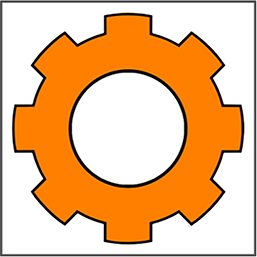Walking in the Dark
- Marsha Balian and Patricia Sonnino at the Gearbox Gallery
- October 16 through November 14, 2020
- Fridays and Saturdays, noon to 5:00 p.m.
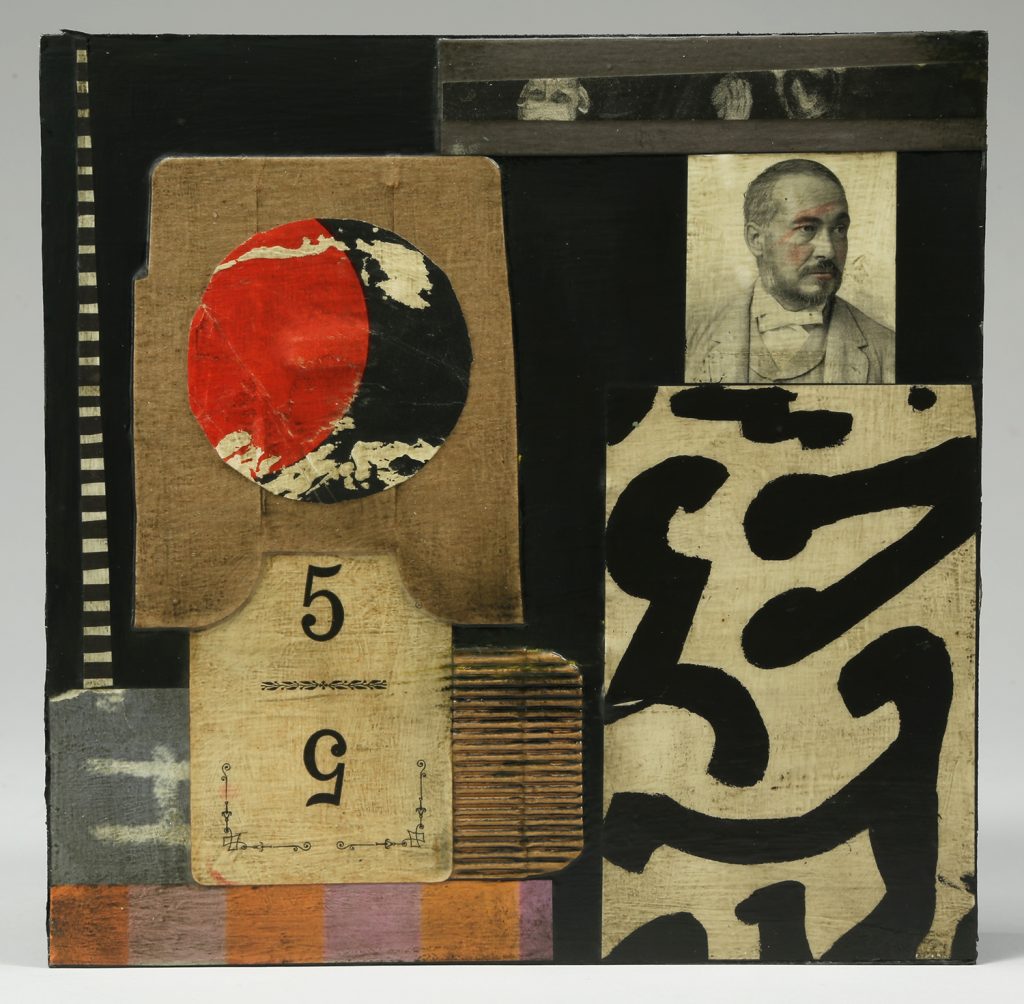
I never know quite where to begin these interviews but I think we’ll just begin with your statement from your website [link below]. One thing I picked out is that you say there are, “…three elements that compel … [my] art.” You go on to designate them as mystery, invention, and story. I see all three going on in your work and the most compelling part for me is the mystery in the storytelling. It seems to me that the story is finding itself in the process.
I’m not trying to convey mystery in my artwork; rather, it’s the mystery of the making of art, the process itself. My work invariably has some narrative elements or perhaps fragments from which people put together their own stories. I never want to tell people what to think, what to feel, in my artwork.
So, are you saying that it is the viewer’s invention from the elements you provide?
It’s my invention because I am self-taught. And because I work with mostly found and disparate objects, I’m the one who has to find some way of putting it all together. That’s the power for me, as the person making the art; I love that process. But it isn’t my story.
Another thing you say in your statement, “…a riddle to be solved, an equation to be resolved, a conundrum to be settled…” So you are also seeking something, maybe it isn’t the story, but you’re resolving something in your own mind.
It is the process itself that I find really compelling. Making art for me is about problem-solving. When making art you solve one problem and create another. That is the process until you work it out to your own satisfaction, maybe like a jigsaw puzzle.
OK, I get that. It’s like a chess game. Every move elicits the next move.
Right. And I find that very compelling and addictive. I never have a blueprint. It is always a process of discovery along the way.
I’m going to backtrack a bit. You’ve done this group of work that you’ve titled Pseudoscience. That is obviously a reference to what we are going through right now: COVID, the pandemic, and all the crazy misinformation we’ve been getting.
It absolutely is.
So, in that sense, you have begun with something. Some sort of general idea or theme.
I almost always work in series. A theme doesn’t necessarily present itself to me before I start the work but once I have begun it will often suggest a theme to me. That’s what happened with this Pseudoscience series. All of us are affected by this crisis and it’s going to inevitably filter into our art but I am not interested in literal interpretations. I came upon this book I had on phrenology [“…the detailed study of the shape and size of the cranium as a supposed indication of character and mental abilities.” From Oxford Languages] and I have this massive collection of found photographs, and then a friend gave me this card set, “Flinch”, that was really mysterious. So I combined those elements.
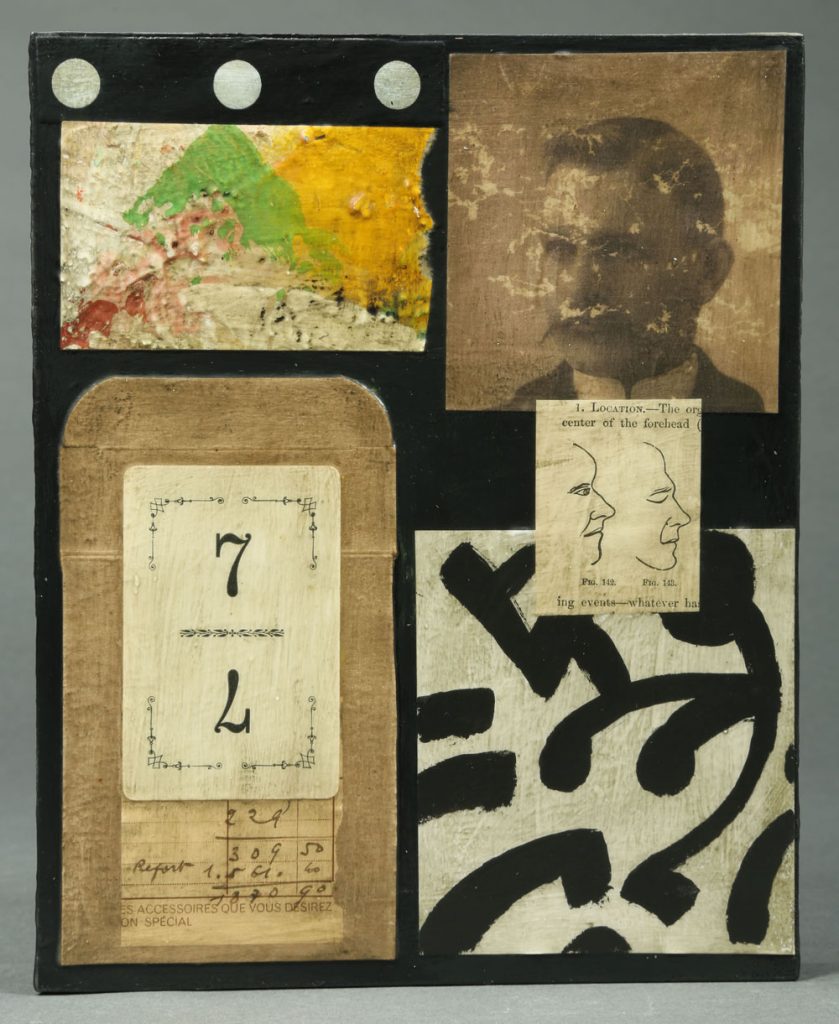
So looking at “Center of the Forehead,” I see the various elements of the cards and photos and references to phrenology but I’m curious about the abstract black and white design at the bottom right. What is that?
It was just the pleasure of painting that. Just letting the brush do what it wants to do. It’s a bit like automatic writing; I’m not dictating it. It just happened. And yes, this design is repeated in some of the other pieces. Yes, it is unique to this series. Because it is a series, there has to be a sort of consistency and this pattern plays a part in that.
I found two somewhat separate paths in this group of work. This piece, “Center of the Forehead,” has a commonality with several other pieces in the series and is also more in sync with your other work that I am aware of. There is another group from this series that I find very different. Let’s talk about “Pretending That Everything Will Be Okay.”
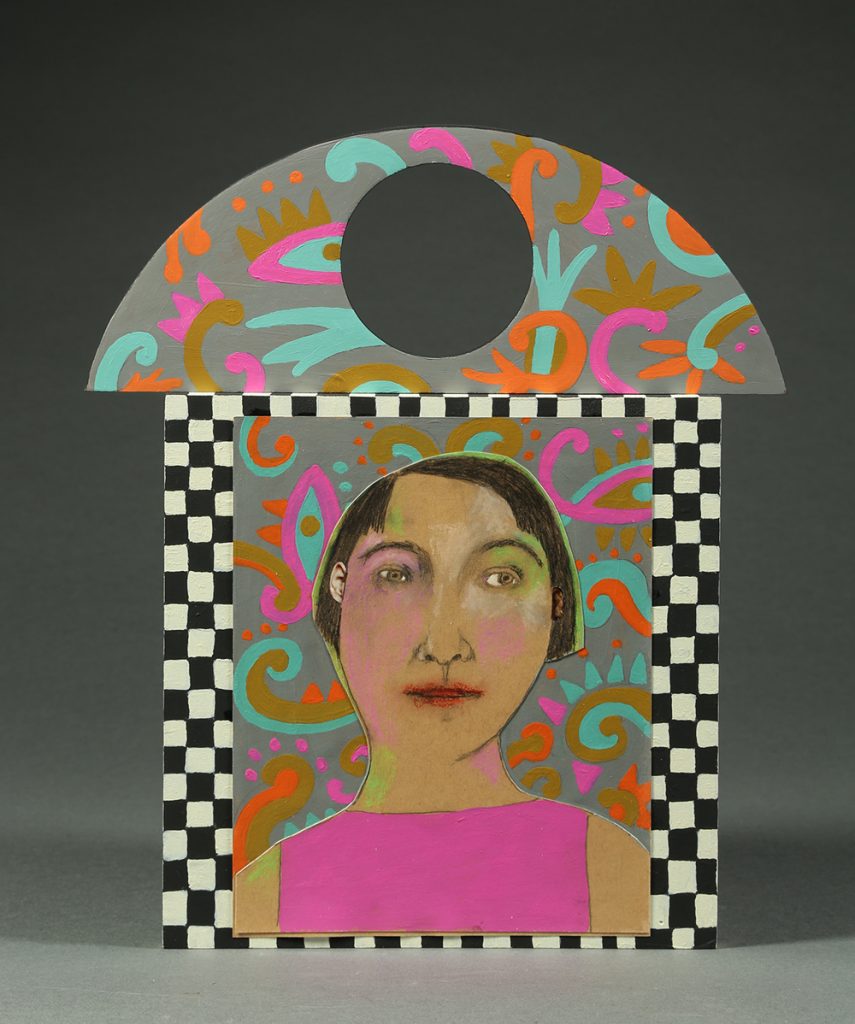
I go back and forth doing abstract and figurative or portrait work. Working abstract is very relaxing for me. But then I am compelled to return to faces and things and so this one is made from the frame around an old clock and the piece it is resting on is very thick, almost four inches. It just worked to put the one piece on top of the other and then I figured a way of unifying them and it just kind of happened and the title came from the way I was feeling at that moment. Things are so disastrous but we have to carry on. Everything I was doing was so sombre, I decided to use bright colors for this one.
So what makes this piece, and a few others in this series, different from the rest is its painterliness. That portrait could stand alone in a frame.
But it isn’t a portrait of anyone, it’s from inside my head.
Yes, I understand, but the point I find so interesting is that it is such an accomplished painting in and of its own. The other point that makes this one of my favorite works of this series is how solid – almost architectural – the way you have combined the various elements of the design. The compositional balance is so strong. You said you like people to invent their own stories so when I look at this I see the clock frame but it is missing the clock. And that circular void is floating above her head almost as if she is thinking about it. And I think about the pandemic and look at your title and there is just so much going on here but I don’t come to any conclusive answer and that’s probably good.
So let’s go to this other piece that I also think of as more “painterly” in the series, “Gyromancy.” [We didn’t discuss the definition of the word but I found this wonderful one in Wikipedia, “Gyromancy is a method of divination in which a person spins around inside or walks the circumference of a circle drawn on the ground, the perimeter of which is marked with the letters of an alphabet. The divination is inferred from the letter at the position where the person either stumbles or falls across the circle’s edge. The person would repeat the practice “…till he evolved an intelligible sentence, or till death or madness intervened. The dizziness brought on by spinning or circling is intended to introduce randomness or to facilitate an altered state of consciousness.”]
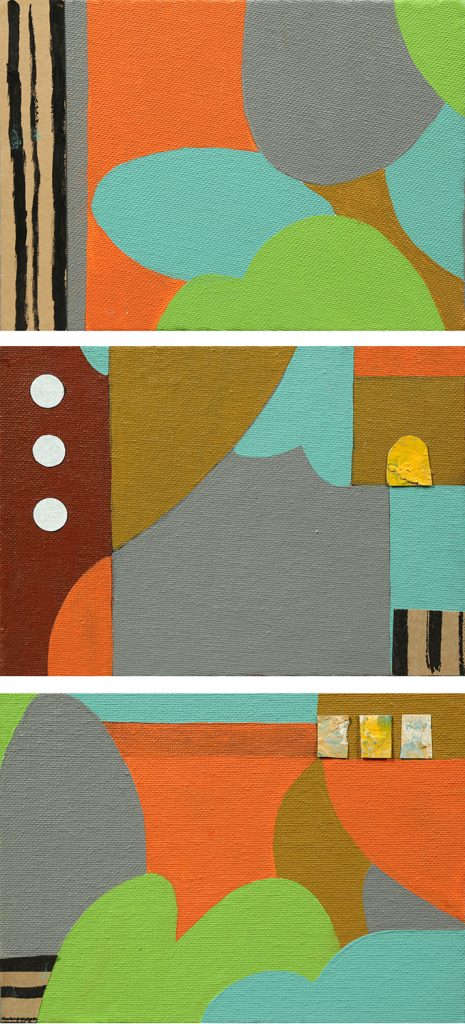
Again, I would say this piece was self-comforting. I love design and graphic elements so I just let myself play. The thing that is so interesting and fun for me with a diptych or triptych is that you not only have to solve the problem aesthetically in one piece but that has to relate to the aesthetic in the other piece or pieces as well. It is a kind of multi-dimensional problem-solving. Each piece has to stand on its own but also work with the other pieces. Yes, in making this piece it became clear that it needed to be vertical [as different from the normal horizontal format for a triptych].
Let’s talk about “What If?” It looks sculptural to me, like a free-standing piece.
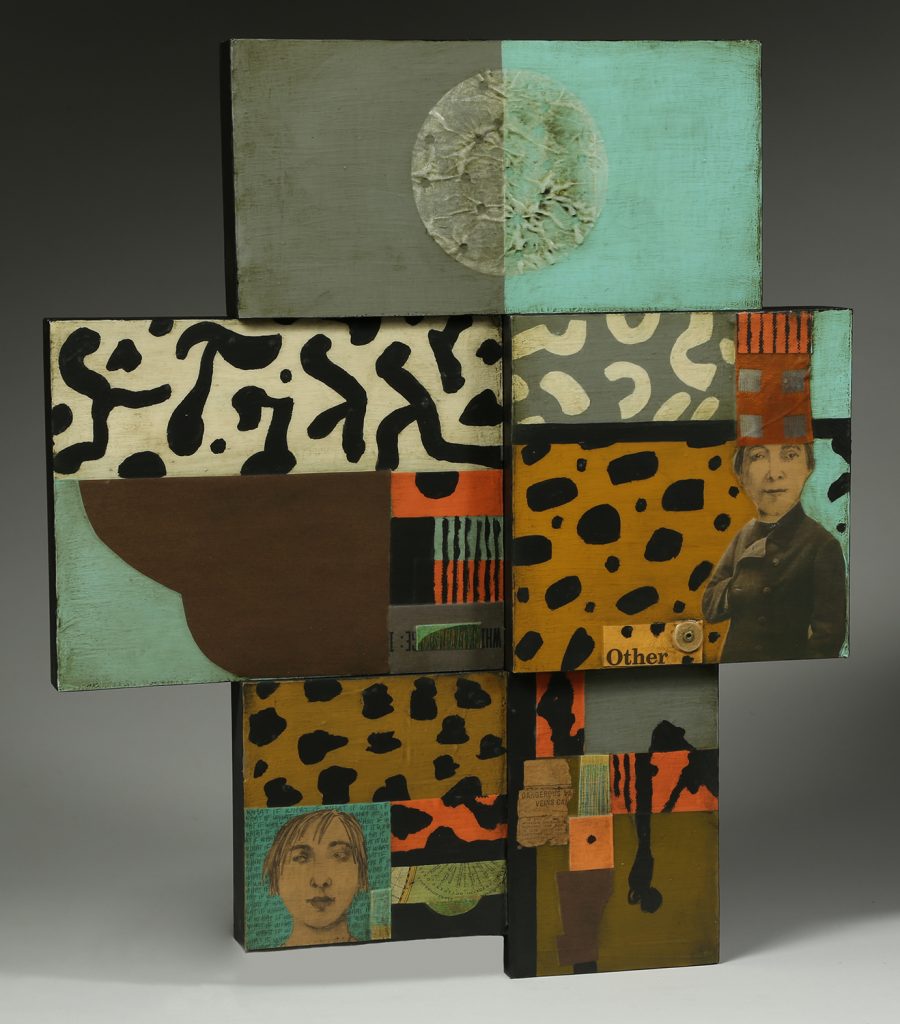
Well, no, it’s not. It actually hangs on the wall. It has six component pieces.
See that circular thing at the top? It is some sort of industrial filter I found and that was the starting point. And then I began with the piece on the lower left bottom and behind that face, it says “what if, what if, what if” and those two words are very representative of anxiety. We’re living in such an anxiety-filled era. I kept adding more pieces and I screwed each piece into each other so it could hang on the wall.
It’s interesting looking at the photograph of the piece because it is free-standing and it looks like a large sculpture. [Discussion about the tricks of photographing artwork.] Scale can be an illusion between the actual object and how it appears in photographs. Scale fascinates me. Sometimes a work that might not be all that good can still have a [slaps hands] because it is eight by ten feet. Conversely, things that are very small are sometimes lost. People don’t see them or they walk by them or they simply don’t register. But the fascinating thing about your work, which is all relatively small, is that it pulls me in. So even though your pieces are all small, they are also very big!
I know you were a Nurse Practitioner in your working career. In this series, Pseudoscience, which has something to do with the pandemic, how much of your experience as a Nurse Practitioner informed this work?
I don’t think it did. What was incredible about my career, and I did it for thirty-four years, was that I heard peoples’ stories. I had that privilege of hearing amazing stories, sometimes secret stories. I’m so grateful for that. Your head becomes filled with those stories and it’s not like I wrote or shared the content of any of them but it is just this punchbowl of feelings that came from listening.
That makes sense to me as your work is all about what’s going on in the mind, either yours or theirs or somebody’s, it’s informed by observation of human behavior and it’s the storytelling that comes of that. It’s all about storytelling for me.
In this pandemic there is a real irony that we are not only having to protect ourselves with social distancing and masks and so on, but we are having to protect ourselves from each other. There’s a sad irony to that. And that brings me to another aspect of your work. You mention in your statement “humor,” that “…humor feeds me and infuses my artwork” and “…if there is a way to convey even a little bit of humor, it confirms the therapeutic benefit of art.” I agree that art can be therapeutic. What I’m asking about in your work is this aspect of humor as it is applied to a subject that is rife with suffering, this pandemic. Because there are some of each in these works, how do you find your way between suffering and humor?
I think that we are really screwed without humor. I’m no stranger to death and suffering but if we cannot look for or appreciate, even if they are just very small, little moments of humor or an opportunity to laugh, it’s just hopeless. We have to be able to step back and see things from that perspective. [So you’re an optimist.] I struggle. But I don’t want to believe it is all for naught. I don’t want to succumb to that attitude. It’s really hard but it’s worth it. So I think that struggle has to be armed with some degree of humor. In dark times I think we need humor even more. Just to read the newspaper is so deeply unsettling. We need to find a counterbalance to that.
So, yes, I’m happy to see the humor in your work.
I always conclude these interviews with a dumb question and even though you’ve already answered it in your statement and in our conversation, the dumb question is, “Why do you do it?”
I don’t think I have a choice, to be honest. It’s because I have to. Once you accept the term “artist” as part of your identity, it’s too much of who you are to not do it. It’s not optional.
